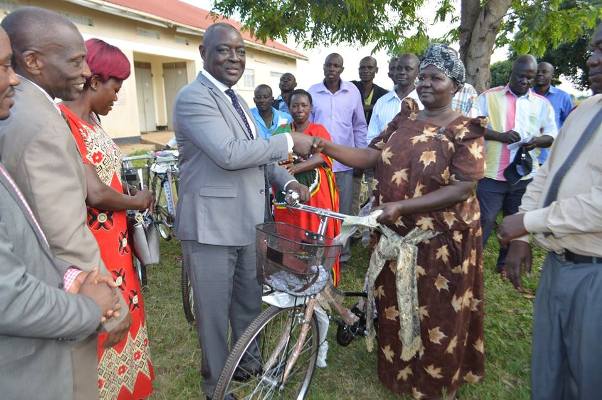Minister Ssempijja handing over a bicycle to a farmer
By Francis Otucu
The 2014 Population and Housing Census figures indicated that close to 80% of the households in Uganda are involved in agriculture sector. This means that the sector is the biggest employer of Ugandans.
The Minister for Agriculture, Animal Industry and Fisheries (MAAIF), Vincent Bamulangaki Ssempijja, says the sector contribution to the national economy still steadily improving.
For instance, he says, between FY 2015/16 and FY 2019/20, the sector contribution to national GDP averaged 24%.
“Over the last five years, the sector has been on track in implementing the 2016 NRM Manifesto whose objective is taking Uganda to modernity through job creation and inclusive development. This has been possible through prioritizing and integrating the Manifesto commitments and the Presidential directives/resolutions in all the programs,” Ssempijja said on Monday at the OPM auditorium as he revealed MAAIF’s performance over the last five years.
Ssempijja said the sector registered improved growth rates from 2.8% in FY 2015/16 to 4.4% in FY 2019/20 while the value of agriculture exports increased from USD 1.326 billion to USD 1.69 billion in FY 2019/20, representing a growth of 27% in the past five financial years.
Ssempijja says the sector employs about 64% of all Ugandans (about 72% youth) highlighting its importance to household income growth and consumption, and thereby stimulating growth in the other sectors.
In the 2016-2021 manifesto, MAAIF committed to among others; increase production and productivity of agricultural commodities and enterprises; increase access to critical farm inputs; improve access to markets and value addition and strengthen the quality of agricultural commodities; and to strengthen the agricultural services institutions and also create an enabling environment for the sector to grow.
Ssempijja reported that to ensure farmers’ access to quality inputs, the Ministry initiated pre-delivery seed quality tests of all input dealers.
For the seedlings, Ssempijja said, prior to their delivery by the suppliers, a joint team of technical officers from NAADS and MAAIF visited the seedling suppliers to ascertain/ verify both the quality and quantity of the seedlings as specified including germination tests.
“These efforts have seen the Ministry significantly reduce counterfeit and adulterated farm inputs on the market,” he said.
He added that the Ministry through NAADS/OWC and other MAAIF Agencies has continued to distribute critical farm inputs.
“In the last five years, the Ministry has distributed; 19,562,506 kgs of maize seed, 7,086,504 kgs of bean seed, 793,223 bags of cassava cuttings, 410,737,788 tea seedlings, 21,526,743 cocoa seedlings, 17,151 Dairy heifers, 3,412 beef cattle, 632,497 poultry – Birds, 7,405,117 fingerlings for tilapia, 121 sets of milk coolers and matching generators, Tractors, 344 motorized pumps and 400 knapsack spray pumps, among others,” he reported.
He says these initiatives have led to an increase in productivity and production in the country leading to surpluses and increased exports.
He says the Ministry has carried out trainings of extension staff and non-state actors on the principles of the four Acre-Land-Model that will be piloted based on the concept of the Village Agent Model
“The Nucleus Farmer Model is intended to streamline ways in which Government will empower progressive farmers in specific value chains to be the means of creating linkages between central Government, Local Governments, Extension services, input dealers, NAADS/ OWC activities, Financial and Insurance service providers, Agriculture Research and other private sector value chain actors, at both parish and sub-county level,” the Minister said, adding: “The model will ease mobilization of farmers into groups and higher-level producer marketing associations and link the farmers to input dealers, traders and financial service.”
So far, he says, the Ministry has procured and distributed 3,720,000 hoes to support 2,450,000 farming households in all regions of the country.
COFFEE IS GOLD
The other commitment MAAIF pledged to achieve was to invest and increase exports of specific commodities such as: Coffee from the current 3.6 million bags (60kg) to 6 million bags; maize – from the current 185,000 metric tons to 1.5 million metric tons; tea – from 65,000 metric tons to 130,000 metric tons; and Beans – from 32,000 metric tons to 500,000 metric tons.
To achieve this, Ssempijja says, the government has distributed 702,324,272 coffee seedlings to coffee farming households.
“These efforts led to an increase in the volume of coffee produced from 4.55 million in FY 2015/16 to 7.75 million in FY 2019/20, an increase of 70%,” he said.
He revealed that the volume of coffee exports increased by 43% from 3.557 million bags exported in FY 2015/16 to 5.103 million bags in FY 2019/20.
“This is the highest volume of coffee that Uganda has ever exported in the last 30 years,” Ssempijja noted.
On the other hand, he said the value of coffee exports increased by 41% from US$ 352 million in FY 2015/16 to US$ 496 million in FY 2019/20.
The increase in the value of coffee exports, he says, is largely due to the current low market levels nationally and globally for both Robusta and Arabica where the average unit price in 2015/16 was USD 2.06 per kg compared to USD 1.62 per kg in 2019/20 and lower 1.70 USD which was projected.
Coffee agro-processing is on the rise, he said.
In the last five years, Ssempijja noted that primary coffee processors/ hullers increased from 454 to 578, coffee roasters increased from 14 to 28, export grading plants increased from 21 to 36 and buying stores increased from 506 to 700.
Maize
Minister Ssempijja says the Ministry distributed a total of 19,562,506 kgs of maize seed to both small holders and commercial farmers in all district local governments in the last five years.
This, he says, resulted in an increase in production of maize by 85% from 2.6 million MT in 2016 to 5 million MT in 2020.
“The volume of maize exports has also increased by 6% from 263,114 MT in 2016 to 278,693 MT in 2019 while the value of exports has increased by 29% from USD 84.99 million in 2016 to USD 109 million in 2020,” he said, attributing it to good rains, distribution of seed by government, increased adoption of improved maize varieties by farmers, increased value addition by private sector and increased vigilance by Government to control pests and diseases.
Tea
The Ministry over the past 5 years has distributed 410,737,788 tea seedlings in 21 tea growing districts. Ssempijja says these efforts have increased tea production by 5% from 67,000MT in the FY 2015/16 to 70,338 MT in FY 2019/20.
He says the sector interventions together with the farmers’ own initiatives has stimulated establishment of more tea factories from 27 to 33 factories.
“These efforts have resulted in a 23% increase in the volume of exports from 54,898 MT worth USD 74.5 million in FY 2015/16 to 67,321 MT worth USD. 71 million in FY 2019/20. Reports indicate over production of leaf in some districts over the existing tea processing capacities, as is the case of Kyenjojo, Kabarole, Kanungu and Buhweju,” he said.
The Minister added: “In addition, 15 new tea factories are being established and are at different levels in several districts including; Kyenjojo (2), Buhweju (4), Kanungu (1), Bushenyi (1), Rukiga (1), Kisoro (1), Ntungamo (1), Kamwenge (1), Mbarara (1) and Luwero (1).”
Cocoa
The Government has distributed a total of 21,526,743 cocoa seedlings to both small holders and commercial farmers in district local governments that prioritize cocoa production in the past five years, Ssempijja says.
Due to this intervention, he says, Cocoa export volumes have increased by 19% from 29,761 MT in FY 2015/16 to 35,318 MT in FY 2019/20 while the value of cocoa exports increased by 3% from USD 75 million to USD 78 million in the last five years.
Fruits (Citrus, Mangoes, Pineapples, Apples)
The ministry says the government distributed 41,426,303 citrus seedlings; 28,706,281 mango seedlings; 2,439,155 apple seedlings and 36,446,670 pineapple suckers.
To this, Ssempijja says these interventions have already resulted into a 45% increase in export volumes of fruits and vegetables from 57,358 MT in 2015 to 83,554 MT in 2020 while the export values have increased by 41% from USD 32.1 million in 2015 to USD 45.23 million in 2020.
Dairy
Ssemijja says there has been an increase in Milk production from 2.08 billion litres in 2015/16 to 2.51 billion litres in 2019/20.
“The volume of marketed milk has been maintained at 80 % between 2015 and 2020,” he revealed.
The export value of milk and milk products has increased by 310% from USD 50 million in 2015 to USD 205 million in 2020, figures show.
Ssempijja attributes this to improved compliance to both regional and international standards and enhanced dairy processing capacities.
“The dairy exports were mainly destined to EAC, COMESA countries, SADC, UAE, Nigeria, Syria, Japan, Oman, USA, Nepal and Bangladesh. More alternative markets in Algeria and China have been found during the implementation of the last Manifesto,” he said.
The Future
Going forward, Ssempijja says the agriculture sector priorities will follow the agro-industrialization programme agenda as enshrined in NDPIII.
The focus, he says, will be on de-risking agribusiness to support commercialization of agriculture following the commodity value chains approach, including; increasing production and productivity, agro-processing, value addition, storage, markets, access to agricultural finance and insurance and institutional strengthening for improved coordination and service delivery.
“The general direction of government through the Ministry of Agriculture, Animal Industry and Fisheries (MAAIF) under the NDPIII is to transform Ugandans from subsistence farming to commercial agriculture,” he said.





